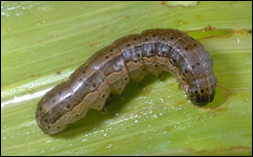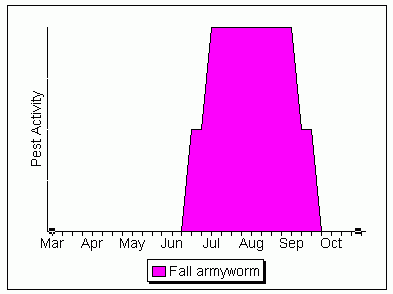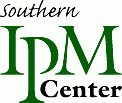Fall Armyworm
Fall Armyworm
Description
Larvae vary from light tan to nearly black with three thin light yellow lines down the back. There is a wider dark stripe and a wavy yellow red splotched stripe on each side. They resemble both armyworms and corn earworms but fall

Fall armyworm
University of Kentucky Dept. Entomology
armyworms have a prominent white inverted Y mark on the front of the head. The spherical gray eggs are laid in clusters of about 150, usually on the leaves of host plants. Egg masses are covered with a coating of moth scales or fine bristles.
Damage
Larvae feed on the leaves leaving "window pane" type damage and later burrow deep into the whorl. The tassel, leaves on the upper portion of the plant, and the ear may be partly or totally destroyed. The damage to the ear of corn may be far more important than the leaf damage. This insect can be a problem in the south following a cold, wet spring. FAW migrate north since they cannot overwinter in the northern states. Other hosts include sorghum and other grasses.
Pest Activity

Please note: These dates are approximations only. This calendar was constructed using data from Kentucky, USA. These dates may not apply in your area. You may wish to contact your county extension agent or agricultural consultant for information tailored to your locality.
IPM Techniques and Scouting Procedures
- Fall armyworms (FAW) will be present in late June to frost. Late maturing fields are most likely to become infested. Begin checking corn in mid-June for fall armyworm activity and continue throughout the season.
- Survey 20 plants from each location, initiating your count randomly. Small larvae will cause "window pane" damage. Record damage, number and size of larvae. Collect specimens for verification. Feeding by small armyworms resembles European corn borer damage.
- A few days before tasseling and silking, check closely for infestations. Look for large larvae in the whorls which will be pushed out by the emerging tassels. These larvae may then attack the very small ears. Egg masses and small larvae may be found on the leaves and behind leaf sheaths. Determine if an infestation of large larvae or small larvae will be present to attack the very small, developing ears. Continue to check closely for this insect until silks begin to dry. Calculate percent damage in the same manner as done for European Corn Borer. Note the average length of the larvae.
Economic Threshold: Egg masses present on 5% of the plants, or 25% of plants are infested with larvae. Treatment must be applied before larvae burrow deep into the whorls or enter ears of more mature plants.
References and Additional Information
- IPM-2 Kentucky Corn IPM Manual
- ENTFACT 110 - Fall Armyworm in Corn


